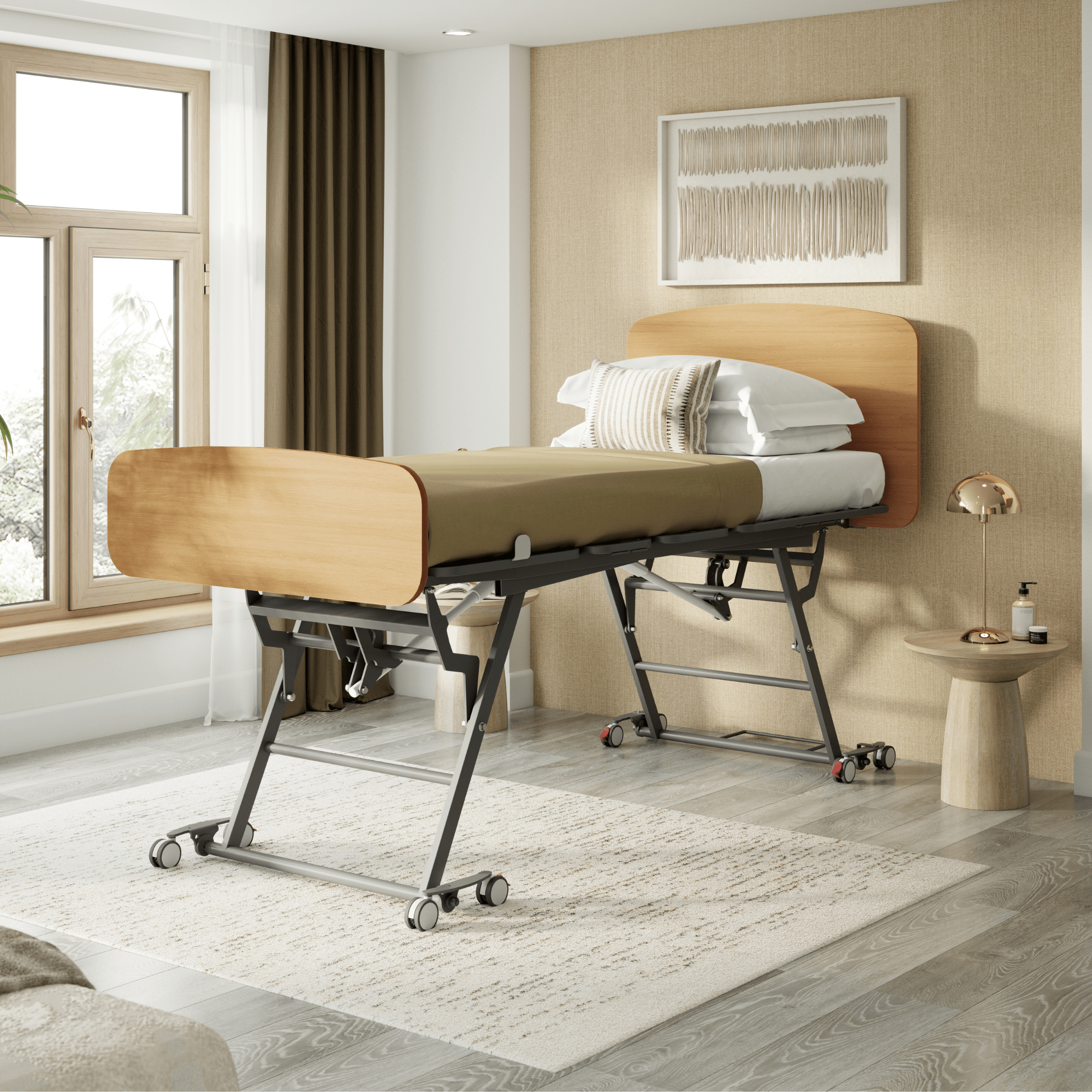How much does a hospital bed cost in 2025?

If you’re searching for a hospital bed for home or for a loved one in long-term care, you’ll quickly see a wide range of prices. Some beds start around $500, while others exceed $10,000.
The right choice depends on how long you’ll use the bed, the level of care needed, and the features that matter most. This guide breaks down what affects hospital bed prices, what you can expect at each price point, and how to choose the right model for your needs.
What affects the cost of a hospital bed?
When comparing hospital bed prices, several key factors influence what you’ll pay. These include how the bed operates, how it’s built, and the level of safety and comfort it provides.
1. Bed Type
One of the main factors that determines how much a hospital bed costs is how it operates. Hospital beds fall into three main categories: manual, semi-electric, and full-electric.
- Manual hospital beds use hand cranks for adjustments. They’re the most affordable option, typically under $600, but require more physical effort to operate and are best suited for short-term recovery.
- Semi-electric hospital beds combine manual and electric controls, usually with powered head and leg movement but manual height adjustment. They cost between $600 and $1,000, offering moderate convenience at a manageable price.
- Full-electric hospital beds automate height, head, and leg adjustments for effortless operation and higher levels of safety. Prices generally start around $800 and can exceed $5,000, depending on additional features.
2. Hospital bed functionality
All adjustable hospital beds share a few basic functions. Even the most affordable models allow users to raise or lower the head and leg sections and adjust overall height to support comfort and caregiving. These essential movements make it easier for individuals to sit up, reposition, or receive care and form the foundation of every bed, regardless of price.
Where costs begin to rise is in the level of precision, range of motion, and clinical technology built into that functionality. Beds with smoother motors, wider height ranges, and additional positioning options provide a higher standard of comfort and safety but require more advanced engineering.
For example, low hospital beds or floor-level beds that can lower close to the floor (under four inches) help prevent injuries from falls, while those that rise to full nursing height protect caregivers from strain during daily care tasks. This extended lift range is typically found in mid-range and premium full-electric hospital beds.
At the top end of the market ($3,000+), advanced pressure care technology further impacts price. Systems such as Accora's BodyMove™ technology follows the body’s natural motion during backrest and leg rest adjustments, reducing friction and pressure on the lower back and buttocks, a key factor in preventing pressure injuries.
These features, along with others such as bariatric models that offer wider widths and higher weight capacities, advanced positioning options such as Trendelenburg and reverse Trendelenburg, all impact the overall cost of a hospital bed.
3. Materials and design
A homelike design adds cost but improves dignity and comfort. Premium electric beds use enclosed mechanics, wood finishes, and modern headboard designs that look more like furniture than medical equipment, an important feature for home hospital beds. In contrast, lower-priced beds prioritize function over aesthetics and tend to look more institutional.
4. Safety accessories
Accessories such as side rails, safety mats, and width or length extensions increase both versatility and overall cost. For example, a floor-level safety mat can create a continuous surface next to the bed, turning potential falls into gentle rolls. Pendant lockouts and smooth-motion motors are additional safety investments that make operation safer for both the bed user and caregivers.
5. Durability and warranty
Electric Beds built for continuous use in professional settings have sturdier frames, reinforced actuators, and replaceable parts. While these models carry a higher upfront price, they last significantly longer and usually include extended warranties, offering better long-term value. If you're looking for a home hospital bed, it may be worth looking at models that are already being used within healthcare communities.
What you get at different price points
Here’s how those differences translate into real-world options at different price points.
Below is a breakdown of what you can expect at several key price levels, from the most affordable manual hospital beds to advanced full-electric models designed for long-term or clinical-grade care.
Under $600 – Manual or semi-electric hospital beds
At this level, you’ll typically find manual or basic semi-electric beds designed for short-term use or light home care.
Typical Features:
- Manual crank or partial electric controls (head and leg adjustment only)
- Limited height range (around 15–25 inches)
- Lightweight frame and basic casters
- Minimal safety accessories, such as half-length rails
- Weight capacity typically 450 lbs
Limitations
- Institutional design
- Not suitable for bariatric care
- Requires manual effort to adjust
Best for: Short-term recovery or when cost is the main consideration.
$800 – Entry-level full-electric hospital beds
These models mark the start of true full-electric functionality, allowing powered adjustment of the head, leg, and height positions.
Typical Features:
- Electric height, head, and leg adjustments
- Limited height range (around 15–25 inches)
- Handheld remote control
- Weight capacity typically 450 lbs.
- Minimal safety accessories, such as half-length rails
Limitations
- Institutional design
- Bariatric weight capacity from $1,200
- No advanced positioning functionality
Best for: Home use where comfort and convenience matter, but advanced positioning and safety features are not essential.
$2,000 – $3,000 Advanced full-electric hospital beds
Beds in this price range are a significant upgrade, with enhanced functionality, smoother motion, and improved safety. They’re often used in assisted living or long-term home care.
Typical Features:
- Electric height, head, and leg adjustments
- Wide lift range (as low as 7 inches, up to 30 inches)
- Auto-contour function, the synchronized movement of head and leg sections to stop the person sliding down the bed.
- Smooth, controlled motors for quiet operation
- Handset lockout options
- Weight capacity around 450–500 lbs
- Extendable length and width
- Basic wood panel finishes
Limitations
- Can still feel institutional
- Limited advanced controls e.g. no Trendelenburg
Best for: Long-term care, fall prevention, and users who require regular repositioning or caregiver assistance.
$3,000 and above – luxury hospital beds
Luxury full-electric beds are built to the same standards used in skilled nursing, rehab, and long-term care communities. They combine maximum safety, durability, and clinical functionality with a homelike design.
Typical features:
- All electric adjustments
- Floor-level positioning (as low as 3.9 inches) to reduce fall injury risk
- Full nursing height (up to 31.5 inches) for safe caregiving
- Advanced pressure care systems such as Accora’s BodyMove™ technology
- Pre-programmed positions for one-touch positioning
- Optional tilt functions (Trendelenburg and reverse Trendelenburg)
- Safety stops and handset lockout options
- High safe working load (up to 600 lbs) for bariatric care
- Extendable length and width options
- Replaceable components and extended warranties
- Furniture-style finishes for residential settings
- Speciality functionality, like rotating functions for easier transfers
- Wide range of optional accessories, such as side rails, assist bars, and safety mats to support advanced clinical needs.
Limitations
- Higher upfront cost
- Can require set-up support
Best for: Long-term or complex care where fall prevention, pressure management, and clinical performance are priorities.
Which Hospital bed should I choose?
Choosing the right hospital bed ultimately depends on your situation and needs. If you'd like a more detailed breakdown of how to match a bed to your care requirements, check out our guide on How to Choose the Best Home Hospital Bed. Here's a quick summary to help you decide:
Choose a premium ($3,000+) full electric hospital bed if:
- You need a bed for long-term use, especially for conditions that require advanced positioning, pressure relief, or safety functions.
- You want a bed with clinical-grade functionality and a design that can blend into the home.
- You are caring for someone with higher support needs and therefore need a bed that can adjust as needs change.
- You're looking for a bed that offers long-term value with the ability to replace parts rather than the entire bed.
- You're looking for a reliable electric bariatric bed.
Recommendation: Check out the Empresa hospital bed that has features that support fall prevention, pressure ulcer prevention and bariatric care. Suitable for long-term care at home or within care facility.
.png)
Choose an advanced ($2,000 - $3,000) electric bed if:
- You want more comfort and adjustability than a budget bed, but don't require floor-level safety or advanced features.
- The bed is for regular household use, with basic profiling functions and a reliable build.
- Cost is important, but you still want a strong balance of quality and functionality.
Recommendation: Check out the Contesa hospital bed that has a floor-level height to support fall prevention. Something not often found at this price level.

Choose a basic electric bed or a manual or semi-electric bed (under $1,000) if:
- You need a bed for short-term recovery or temporary care.
- You only require the essentials: electric head/foot adjustment, basic rails, and motorized height adjustment.
- Price is the deciding factor, and advanced safety or design features are not necessary.
Final Thoughts
Hospital beds vary widely in price because they serve different purposes. Basic electric beds provide essential functionality at the lowest cost. Advanced full-electric beds strike a balance between comfort and value, while premium clinical-grade beds offer the highest standards of safety, adjustability, and long-term durability.
If you’re purchasing for home use, consider what level of care it must support. For families or facilities focused on fall prevention, comfort, and longevity, premium models like the Accora Contesa and Accora Empresa provide the best long-term investment.
FAQs
How much does an average hospital bed cost?
Most full-electric hospital beds for home use cost between $1,000 and $2,500. Basic models start around $700, while premium, clinical-grade beds with advanced safety and pressure care features can exceed $5,000.
How much do bariatric hospital beds cost?
A basic electric bariatric bed starts at around $1,200, offering a wider frame and higher weight capacity. Models with advanced features such as full-electric height adjustment, floor-level positioning, or pressure care technology typically range from $3,000 to $6,000 or more, depending on size, functionality, and build quality.
What kind of bed will Medicare pay for?
Medicare will cover a hospital bed if it’s medically necessary for your condition. Your doctor must prescribe the bed and explain how it supports your treatment. Coverage falls under Medicare Part B, which typically pays 80% of the approved cost. There may be specific requirements or caveats, so it’s best to check the official Medicare website for the most up-to-date information.
Is it cheaper to rent or buy a hospital bed?
For short-term use (under three months), renting is often cheaper. For long-term care, purchasing a bed provides better value, especially when it can be serviced or upgraded over time.


